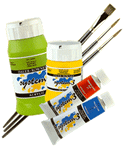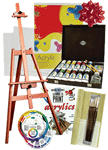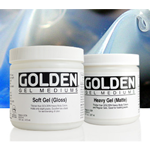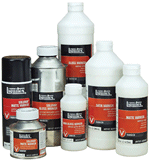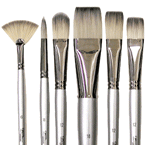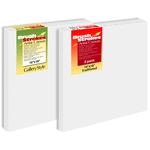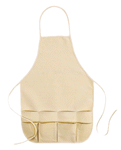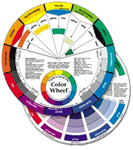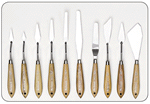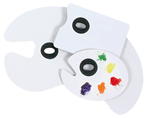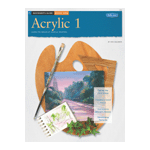FLUID MEDIUMS - Medium Viscosity
Do not shake, as this will create foam. Foam can severely effect the transparency of the film by creating a visual foggy or hazy quality.
Attributes
- Self-leveling, resulting in easier brush free surfaces.
- Mix into Medium Viscosity Concentrated Artist Color to maintain paint viscosity.
- Mix into High Viscosity Artist Color to reduce paint viscosity.
- Mix into High Viscosity and Extra High Viscosity Mediums to produce mediums that varying thickness, sheen and visual effect.
Refer to Part I Mediums: General Attributes of Liquitex Mediums for more information.
GLOSS MEDIUM & VARNISH
Attributes
- Mix with any acrylic paint to enhance the depth of color intensity, increase transparency, gloss, ease flow of paint and add flexibility and adhesion of paint film.
- Use as a non-removable varnish to protect painting and establish gloss sheen surface.
- Translucent when wet, transparent (clear) when dry.
Application
Refer to the following Part I Varnish and Part 2 Applications & Techniques Sections: Acrylic Sheets,Airbrush, Brushwork, Collage, Glazing, Murals and Transferring Printed Images.
As An Extender:
- Mix with Medium Viscosity Concentrated Artist Color to extend volume and increase transparency, while maintaining paint viscosity.
- Mix with High Viscosity Artist Color to extend volume and increase transparency, while decreasing paint viscosity.
As A Fixative:
- Use as a fixative over artwork (acrylic paint, pastel, graphite, chalk) to increase gloss or shine. Mix 1 part Gloss Medium & Varnish with 1 part distilled water. Apply with atomizer or airbrush.
As A Ground:
- Use as transparent ground instead of gesso. Allows substrate to be seen. To prevent Substrate Induced Discoloration wash cotton or linen canvas before use.
Refer to Part I Matte Medium: SID definition.
With Powdered Pigments:
- Use as a binder with powdered pigments to make an inexpensive student grade medium viscosity gloss paint.
MATTE MEDIUM
Attributes
- Creates a matte or dull, non-reflecting finish when added to acrylic colors.
- Mix into any acrylic paint to increase transparency and extend color, increase matte sheen and film integrity, ease flow of paint and add flexibility and adhesion to paint film.
- Mix with Gloss Medium & Varnish to produce a semi-gloss or satin medium.
- Opaque when wet, translucent when dry.
Application
Refer to the following Part 2 Applications & Techniques Sections: Acrylic Sheets, Brushwork, Collage, Muralsand Surface Preparation
As An Extender:
- Mix with Medium Viscosity Concentrated Artist Color to extend volume and increase translucency, while maintaining color viscosity.
- Mix with High Viscosity Artist Color to extend volume and increase translucency, while decreasing color viscosity.
As A Fixative:
- Use as a fixative over artwork (acrylic paint, pastel, graphite, chalk) to decrease gloss or shine
- Mix 1 part Matte Medium with 1 part distilled water and apply with atomizer or airbrush.
As A Ground:
- Recommended fluid medium to use as a transparent ground (size), with excellent tooth and adhesion, instead of gesso. This will allow the color and texture of the support to show through. Can be used as a substitute for the hide glue size traditionally used for oil paintings.
- To prevent Substrate Induced Discoloration (S.I.D.), wash canvas before use.
- SID Definition: When used as a size over cotton, linenand hardboard, acrylic mediums draw substances out of the support as theydry and continue over time. Discoloration can occur in areas that are leftunpainted.
- Exterior Murals: If the support or wall is somewhat smooth, a coat of Matte Medium should be brushed or two coats sprayed onto the surface prior to applying gesso.
IRIDESCENT / PEARLESCENT TINTING MEDIUM
Attributes
- Available in Fine and Medium Grade.
- Produces a range of iridescent or metallic colors when mixed into acrylic colors.
- Opaque when wet, translucent when dry.
Directions
- Mix with small amounts of color, gradually adding more color until desired iridescent quality and transparency is achieved.
- Transparent and translucent colors work best. Opaque colors can also be used.
- Color will become more transparent as percentage of medium increases.
- Colors increase in their iridescent quality and become much more reflective upon drying.
- For Mother of Pearl color, use directly from container.
- For use on fabric, thin 50% with water.
- Higher concentrations will lighten dark colors.
Application
Refer to the following Part 2 Applications & Techniques Sections: Acrylic Sheets, Collage, Glazingand Transferring Printed Images.
MATTE OPAQUE EXTENDER MEDIUM (Jarpaque)
Attributes
- Increases the volume of paint, while maintaining the opacity of the color.
- Economically doubles the volume of Medium Viscosity Concentrated Artist Color with little or no noticeable loss in color intensity, opacity or change in hue.
- Opacity of colors mixed with Matte Opaque Extender Medium will be higher than if the color had been thinned to the same degree with any other medium except Modeling Paste.
- The degree to which the color can be extended will vary among the different pigments.
- When over 50% is added, Matte Opaque Extender can act as a weak tinting white, increasing the value of the original color approximately one level. Light colors will be affected less than dark colors.
- Colors mixed with Matte Opaque Extender dry to a matte sheen, giving colors a gouache look.
Application
Refer to Part 2 Applications & Techniques: Collage & Textures andMurals
Gouache:
- Mix with opaque Medium Viscosity Concentrated Artist Color for a matte sheen and gouache (opaque watercolor) look.
- These "gouache" colors are water resistant, flexible, lightfast and permanent when dry. Traditional gouache colors are not and are susceptible to accidental re-wetting and must be well protected when finished.
Murals:
- Mix into Medium Viscosity Concentrated Artist Color for underpainting of murals to economically double the volume of paint, For top layers use Lightfastness I colors without Jarpaque.
- Running out of color during painting:
- Use when running out of a MediumViscosity Concentrated Artist Color mixture while painting. When you have reached the half way point of painting a specific area, determine if you have enough paint to finish. If not, add an equal amount of Matte Opaque Extender Medium to the color. The color and opacity will be unchanged, but the volume will be doubled enabling you to finish painting without re-mixing.
Underpainting:
- Mix into Medium Viscosity Concentrated Artist Color during initial underpainting, to double amount of color. Medium Viscosity Concentrated Artist Color has three times the coverage of High Viscosity Artist Color.
FABRIC MEDIUM
Attributes
- Enhances the workability of acrylic paint on fabric.
- Controls bleeding of colors when thinned with water.
- Provides a smooth, consistent flow to Medium Viscosity Concentrated Artist Color.
- Prevents uneven application of paint to rough textured fabrics.
- Eliminates stiffness of dried acrylic paint on fabric.
- Eliminates the need to scrub or abrade rough textured fabrics in order for paint to adhere to or penetrate into surface.
- Does not require heat setting.
Application
Refer to Part 2 Applications & Techniques: Fabric
Painting on Fabric
- Begin by adding medium 1:1 with Liquitex Medium Viscosity Concentrated Artist Color.
Color Blending on Fabric
- Mix into acrylic colors to improve wet-on-wet blending techniques.
- Medium can be added directly onto fabric to blend color.
Watercolor on Fabric
- Use Fabric Medium 5:1 with Liquitex Medium Viscosity Concentrated Artist Color to control color bleeding.
GLOSS BLENDING & PAINTING MEDIUM
Attributes
- 100% acrylic polymer emulsion that improves flow of paint and extends drying time.
- Decreases drag (friction) and visual brushstrokes.
- Mix with Medium Viscosity Concentrated Artist Color, to thin paint while retaining body.
Application
Refer to Part 2 Applications & Techniques: Brushwork


